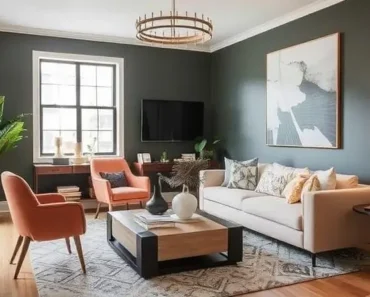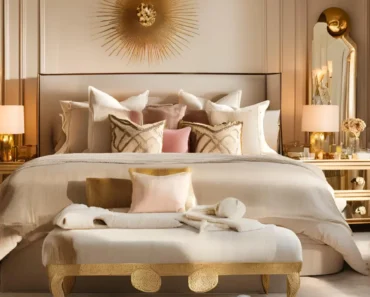This guide presents a curated Chic Curtain Color Ideas List, offering sophisticated and stylish pairings suitable for a variety of aesthetics and room types. We’ll touch upon why color matters so much for your window treatments, explore some foundational color concepts, and then dive into specific combinations that can elevate your home decor. Prepare to discover how thoughtful Curtain Color choices can bring a new level of chic to your living spaces.
The Impact of Curtain Color: More Than Just Fabric
Before we jump into our Chic Curtain Color Ideas List, let’s briefly explore why this particular decor decision carries so much weight. It’s not just about picking a pretty fabric; the Curtain Color you choose interacts with light, space, and other elements in your room in powerful ways.
Setting the Room’s Atmosphere

Color is a potent mood-setter. Light, airy curtain colors can create a sense of calm and spaciousness, perfect for a relaxing bedroom or a sun-filled living area. Think soft blues, gentle greys, or creamy whites. On the other hand, deep, rich curtain colors like navy, emerald, or charcoal can introduce a feeling of drama, luxury, or cozy intimacy, ideal for a formal dining room or a snug den. The Curtain Color you select becomes a significant part of the room’s emotional canvas.
Working with Light and Space Perception
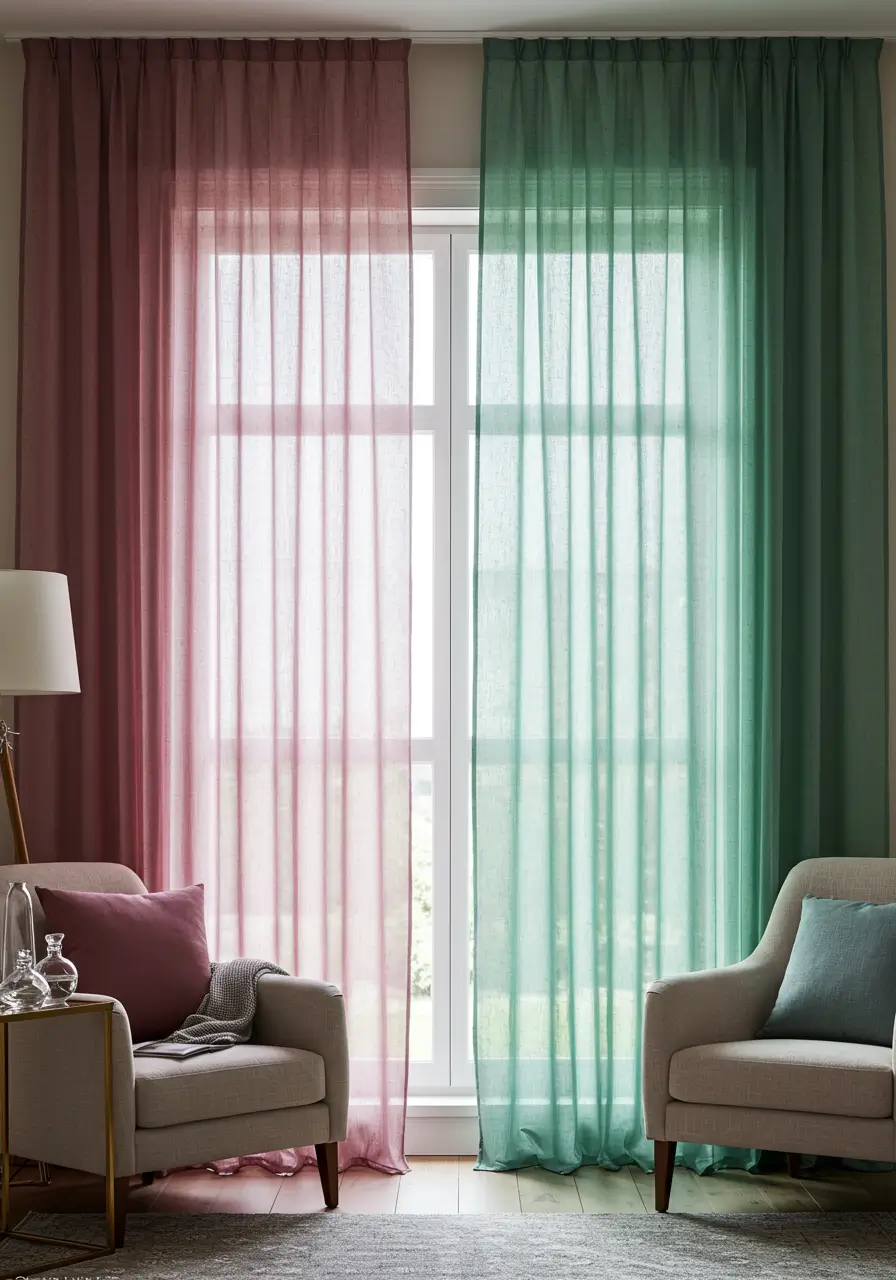
The way a Curtain Color interacts with natural and artificial light can dramatically alter how a room feels. Lighter colors tend to reflect light, making a space feel brighter and potentially larger. Darker colors absorb light, which can make a room feel cozier or more enclosed – sometimes a desired effect, sometimes not, depending on the room’s size and natural light levels. Sheer curtains, regardless of color, allow diffused light to enter, creating a soft, ethereal glow, while opaque, heavy drapes offer complete light blockage and a more substantial visual presence.
Creating Cohesion with Your Decor
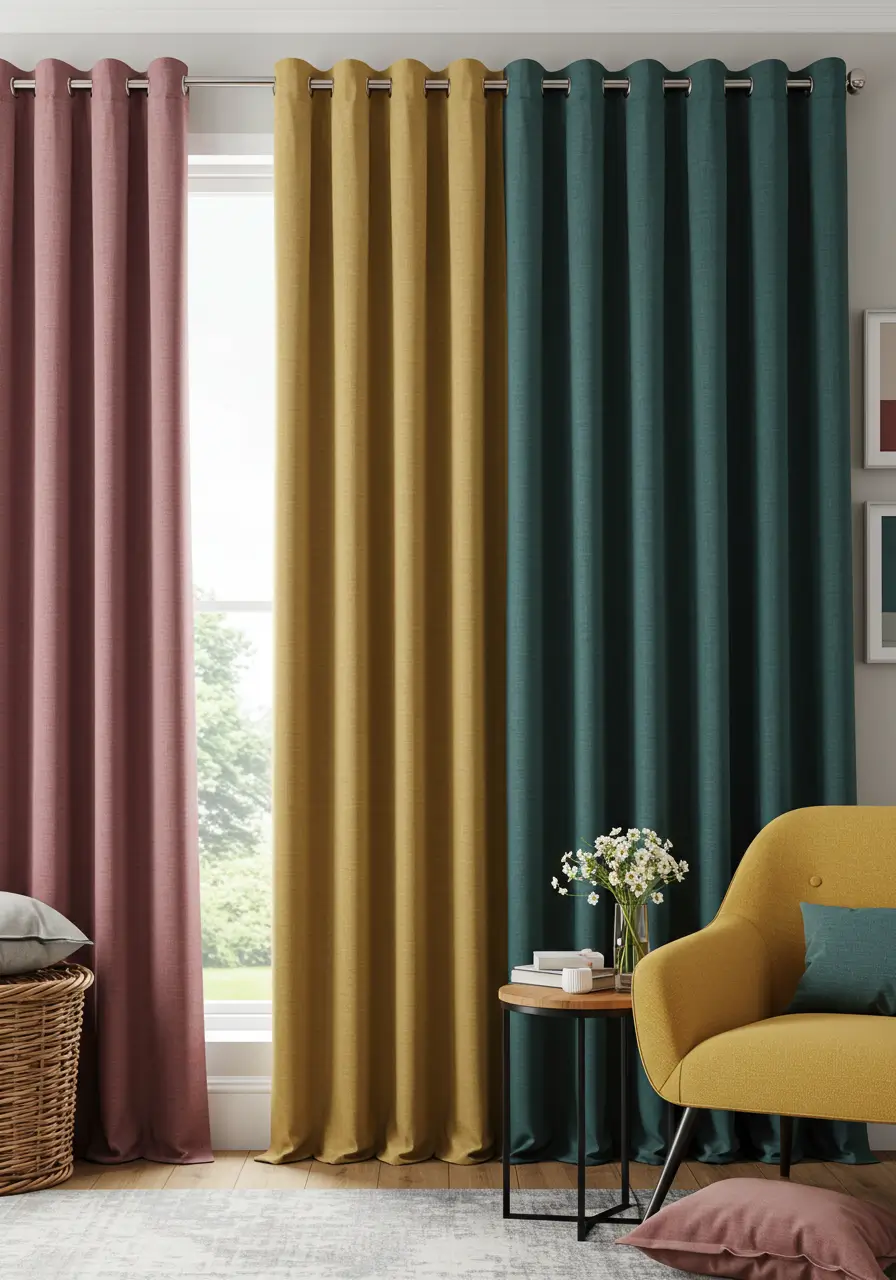
Curtains are a fantastic tool for unifying a room’s decor. Your chosen Curtain Color can echo an accent shade from a rug, a piece of artwork, or throw pillows, tying these disparate elements together into a harmonious whole. They can also provide a contrasting element that makes other colors in the room pop, or blend seamlessly with wall colors for a more subtle, monochromatic effect. The goal is to create a visual conversation between your window treatments and the rest of your interior design.
A Quick Guide to Color Harmony for Curtains
A little understanding of color relationships can go a long way in ensuring your Curtain Color choices are chic and not chaotic. The color wheel is your best friend here!
Monochromatic Magic

This involves using various tones, shades, and tints of a single color. For example, if your walls are a pale sage green, you might choose curtains in a slightly deeper, richer sage. This creates a sophisticated, layered look that is both calming and cohesive. It’s an easy win for an elegant Curtain Color scheme.
Analogous Allure
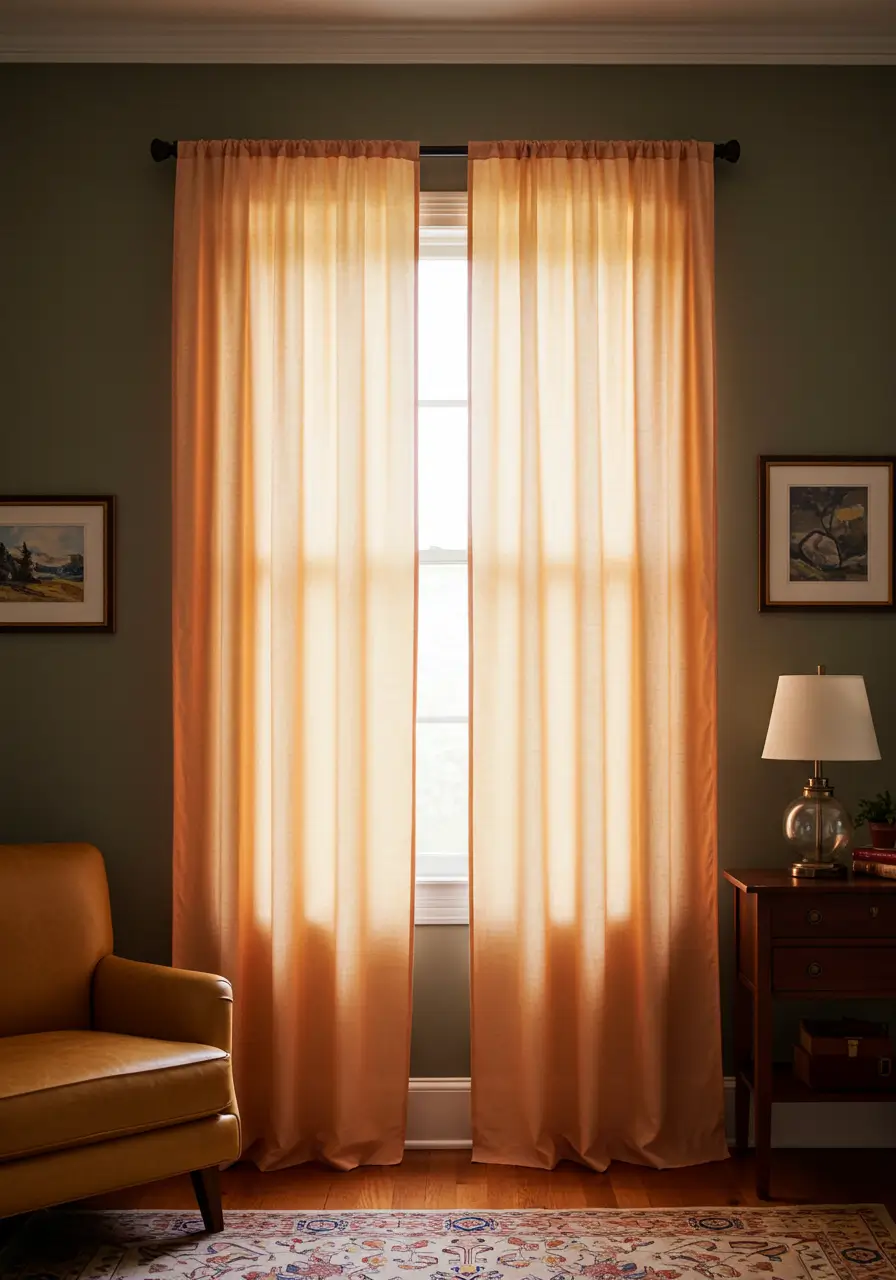
Analogous colors sit side-by-side on the color wheel (like blue and teal, or yellow and orange). Using these for your walls and curtains creates a rich, blended effect that feels harmonious and often found in nature. Imagine soft yellow walls with peachy-orange curtains – warm and inviting!
Complementary Confidence
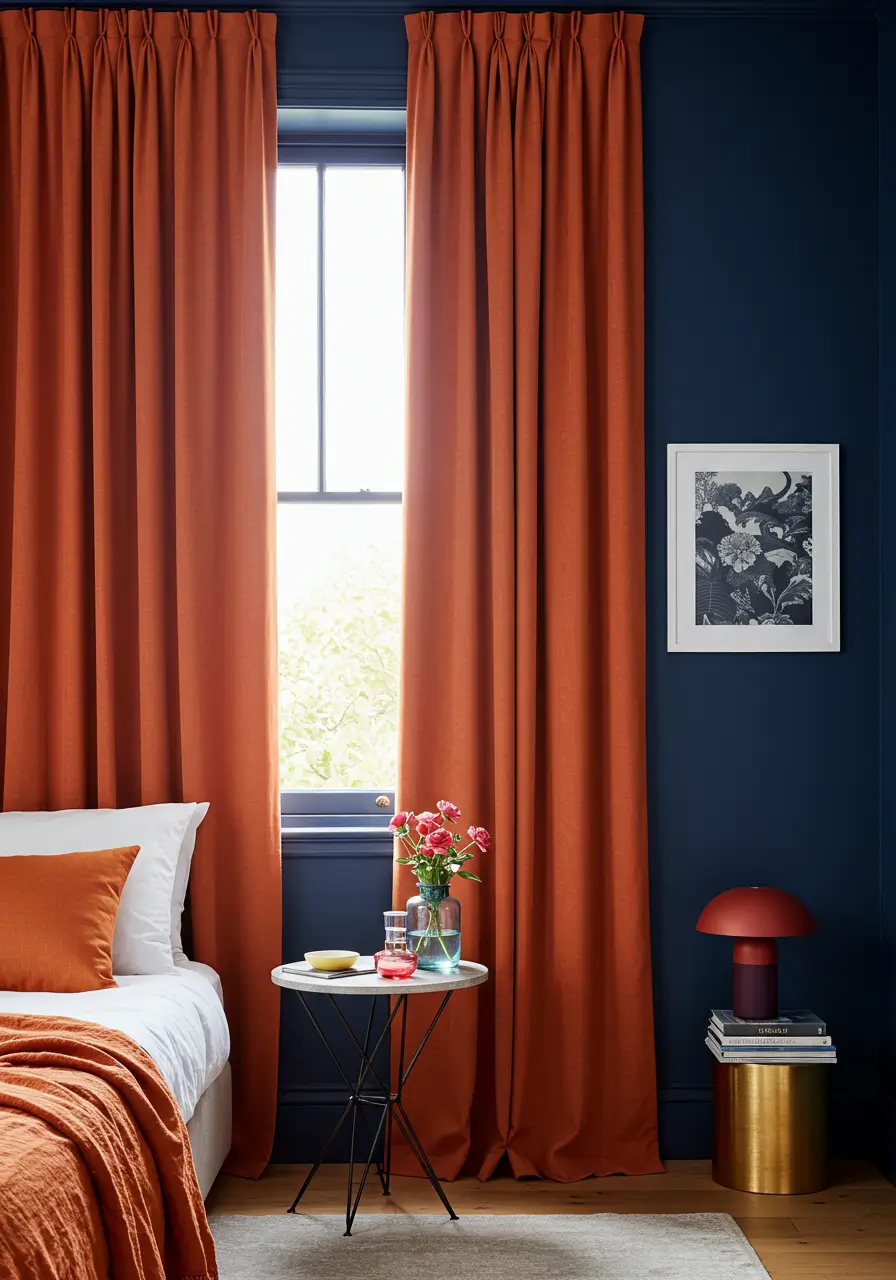
Complementary colors are opposites on the color wheel (like blue and orange, or purple and yellow). This pairing creates high contrast and makes both colors appear more vibrant. A navy blue accent wall with curtains in a burnt orange or deep coral makes a bold, confident statement. Use this approach thoughtfully to avoid overwhelming the space.
The Power of Neutrals
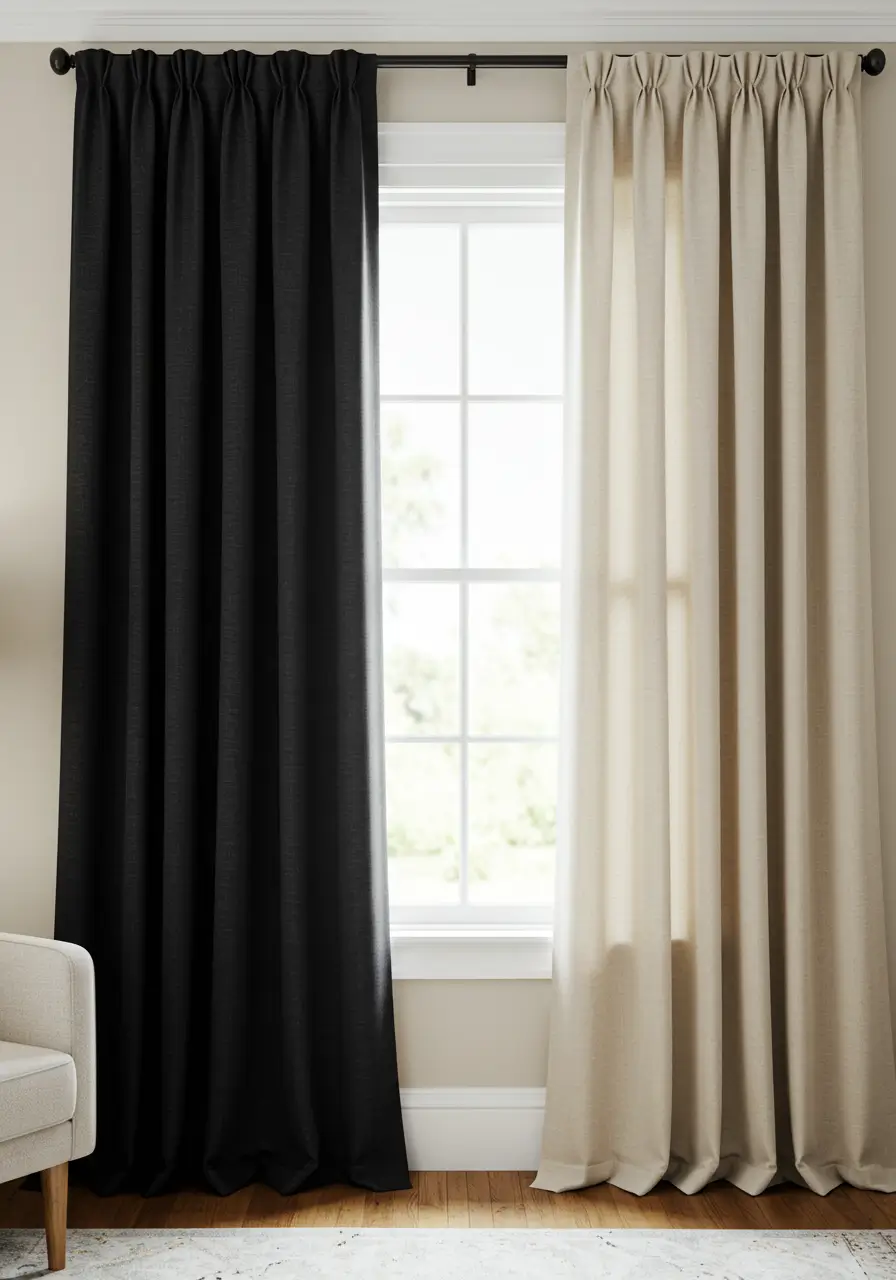
Neutrals (white, cream, beige, grey, black, tan) are the chameleons of the decor world. They can provide a calming backdrop, allowing other elements to shine, or they can be layered for a sophisticated, textured look. Neutral curtains are incredibly versatile and work with almost any wall color or decor style, making them a perennially chic Curtain Color choice.
Our Chic Curtain Color Ideas List
Let’s explore some stunning and sophisticated curtain color combinations that are sure to elevate your home decor. This list offers a range of options, from subtle elegance to bold statements, helping you find the perfect Curtain Color pairings.
1. White Curtains with Soft Grey Walls
The Vibe:
Airy, minimalist, sophisticated, and clean. This combination is a modern classic that maximizes light and creates a serene, uncluttered feel.
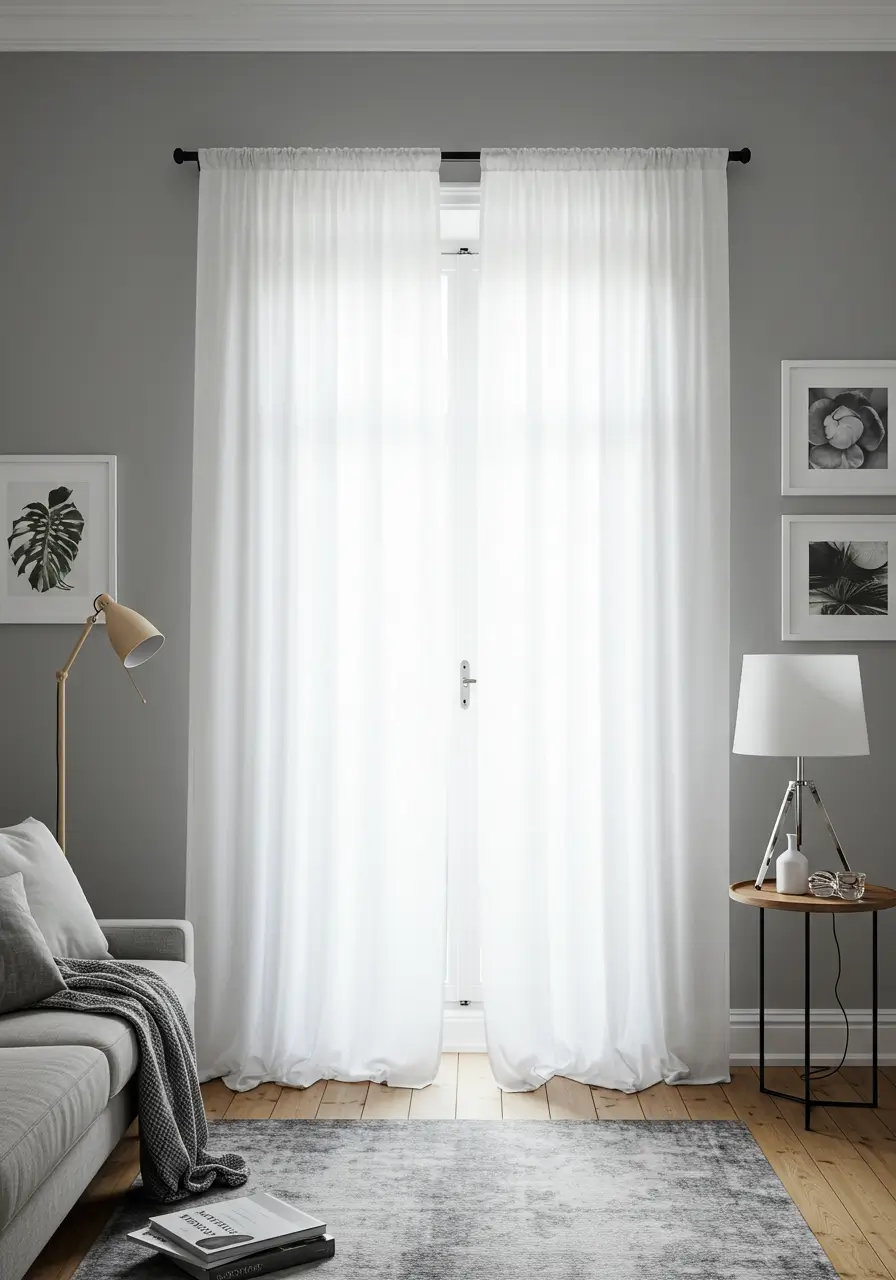
Why it’s Chic:
Crisp white curtains against soft grey walls provide a subtle contrast that feels elegant and refined. The grey offers a touch of warmth or coolness depending on its undertones, while the white keeps the space bright. It’s a perfect backdrop for Scandinavian, minimalist, or contemporary decor styles. Sheer white curtains are particularly effective in this pairing for a light-as-air look.
Best Rooms:
Living rooms, bedrooms, home offices.
2. Navy Blue Curtains with Cream or Off-White Walls
The Vibe:
Timeless, nautical, sophisticated, and grounding. This pairing offers a strong yet classic contrast.
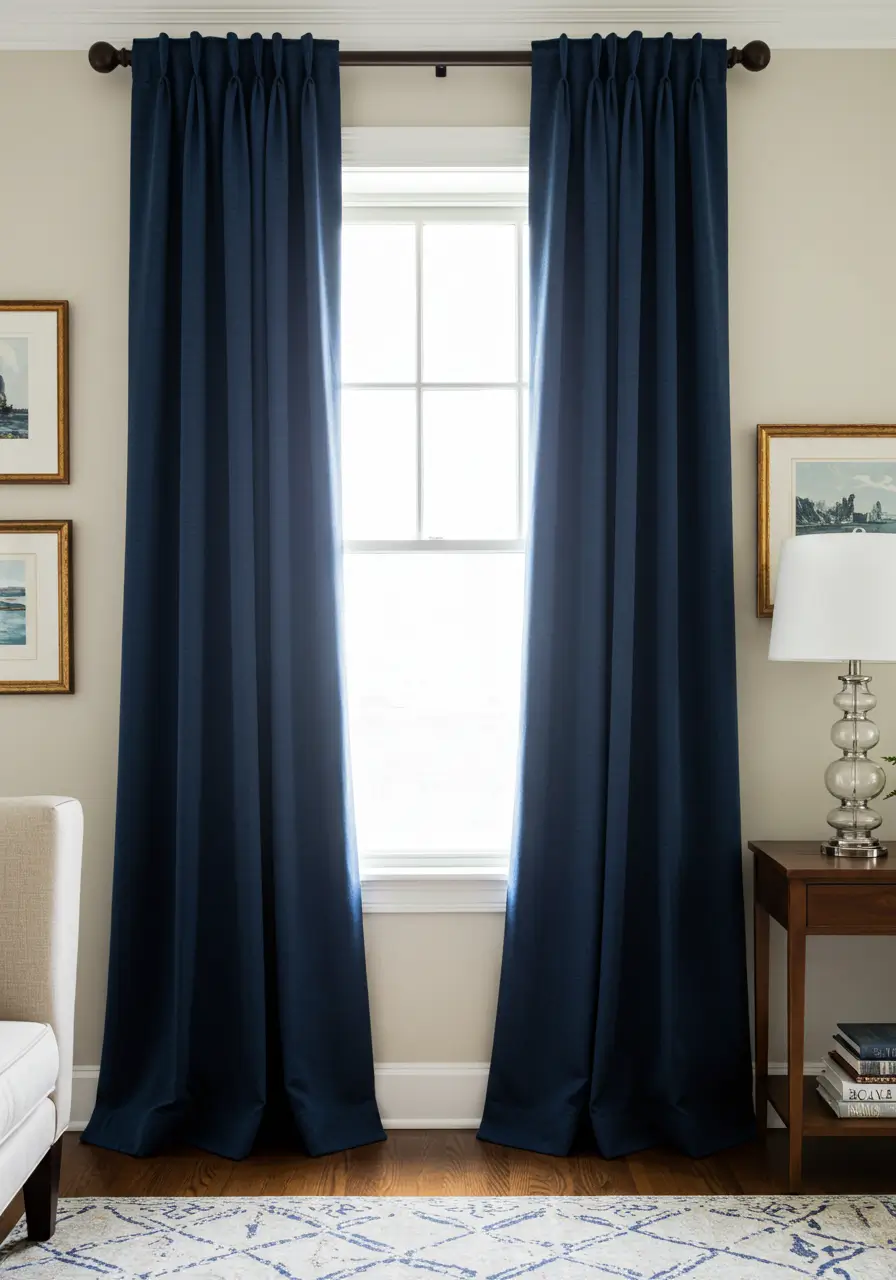
Why it’s Chic:
Deep navy blue curtains act as a rich, dramatic anchor against the warmth of cream or off-white walls. The contrast is visually striking but not jarring. This combination lends itself well to traditional, transitional, and coastal interior styles. Consider velvet or linen for the navy curtains to enhance texture. This is a powerful Curtain Color statement.
Best Rooms:
Master bedrooms, formal living rooms, dining rooms, studies.
3. Emerald Green Curtains with White Walls and Gold Accents
The Vibe:
Luxurious, glamorous, opulent, and nature-inspired.

Why it’s Chic:
Rich emerald green curtains, especially in a fabric like velvet, make a bold and luxurious statement against crisp white walls. The white keeps the look fresh and prevents the deep green from overwhelming the space. Adding gold or brass hardware (curtain rods, tie-backs) or other gold accents in the room enhances the opulent feel.
Best Rooms:
Living rooms, dining rooms, master bedrooms where a touch of drama and Art Deco or Hollywood Regency glamour is desired.
4. Charcoal Grey Curtains with Blush Pink Walls
The Vibe:
Modern, romantic, sophisticated, with a soft edge.

Why it’s Chic:
The deep, moody tone of charcoal grey curtains provides a stunning contrast to the soft, delicate hue of blush pink walls. This pairing balances masculine and feminine energies beautifully, creating a space that feels contemporary and inviting. It’s an unexpected yet highly effective Curtain Color combination.
Best Rooms:
Bedrooms, nurseries, living rooms, or even a chic home office. Works well with modern or eclectic styles.
5. Beige or Linen Curtains with Olive Green Walls
The Vibe:
Earthy, calming, natural, and warm.
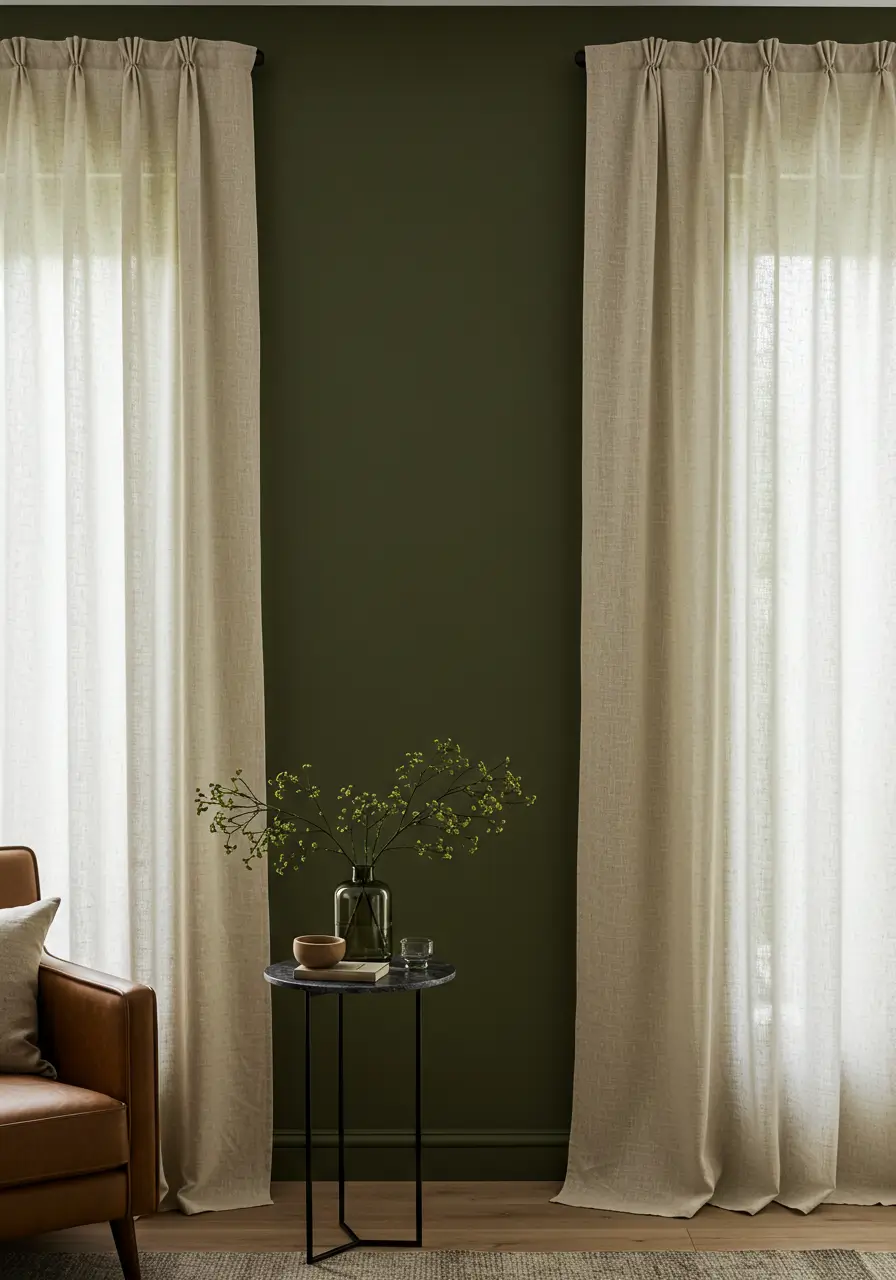
Why it’s Chic:
Olive green walls create a sense of depth and connection to nature. Pairing them with neutral beige or natural linen curtains keeps the focus on the rich wall color while adding softness and texture. This combination feels grounded, organic, and effortlessly stylish.
Best Rooms:
Living rooms, studies, bedrooms, or any space aiming for a biophilic design or a relaxed, modern farmhouse aesthetic.
6. Mustard Yellow Curtains with Teal or Deep Blue Walls
The Vibe:
Bold, retro, artistic, and energetic. This is a complementary color scheme that really pops.
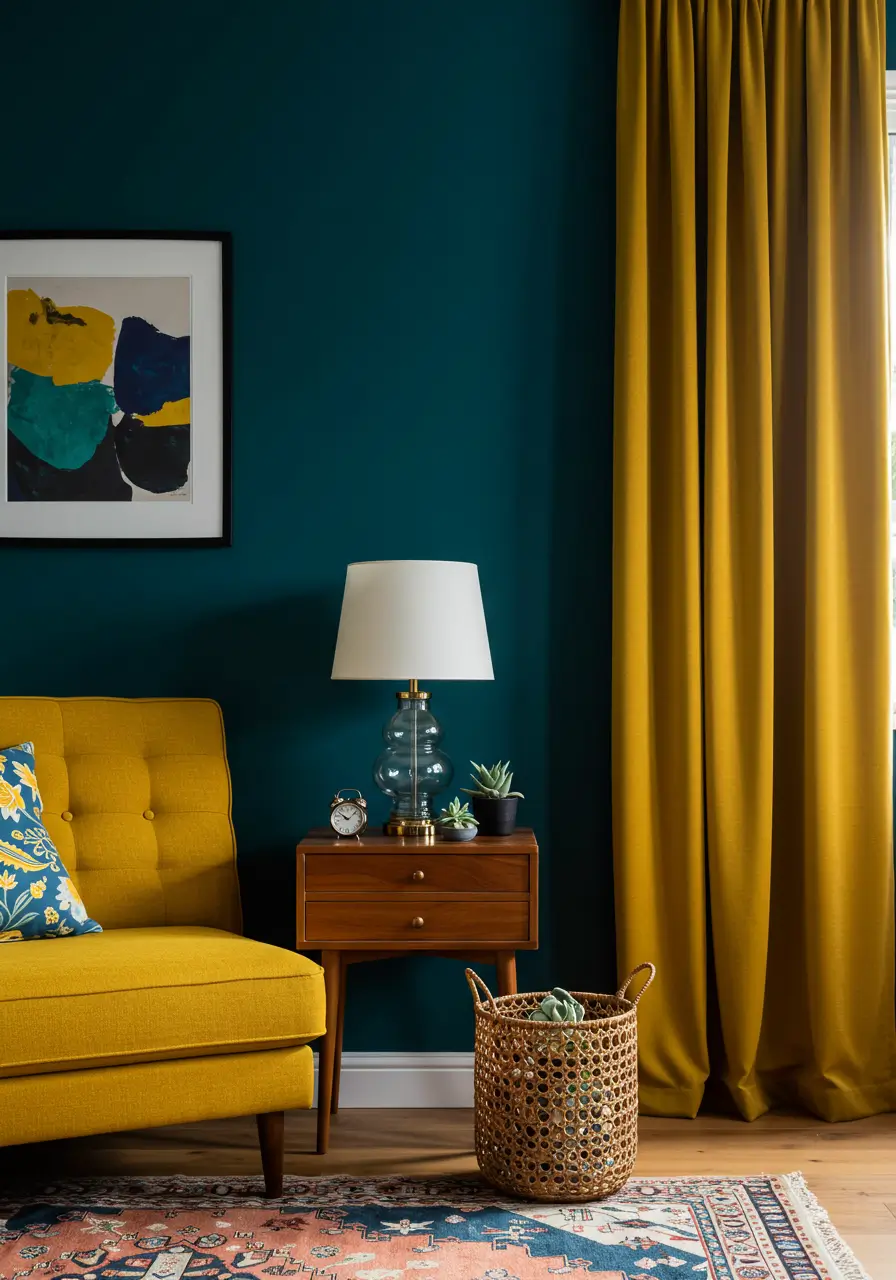
Why it’s Chic:
The warmth and vibrancy of mustard yellow curtains create a striking contrast against the cool depth of teal or navy blue walls. This combination is perfect for those who love color and want to make a design statement. It often evokes a mid-century modern or bohemian feel. This Curtain Color choice shows confidence.
Best Rooms:
Living rooms, dining rooms, creative studios, or any space that can handle a bold injection of color.
Related Posts: Circular Booth Seating: 10 Chic Ideas for Modern Dining Rooms
7. Cream or Ivory Curtains with Warm Terracotta Walls
The Vibe:
Earthy, cozy, Southwestern-inspired, and inviting.
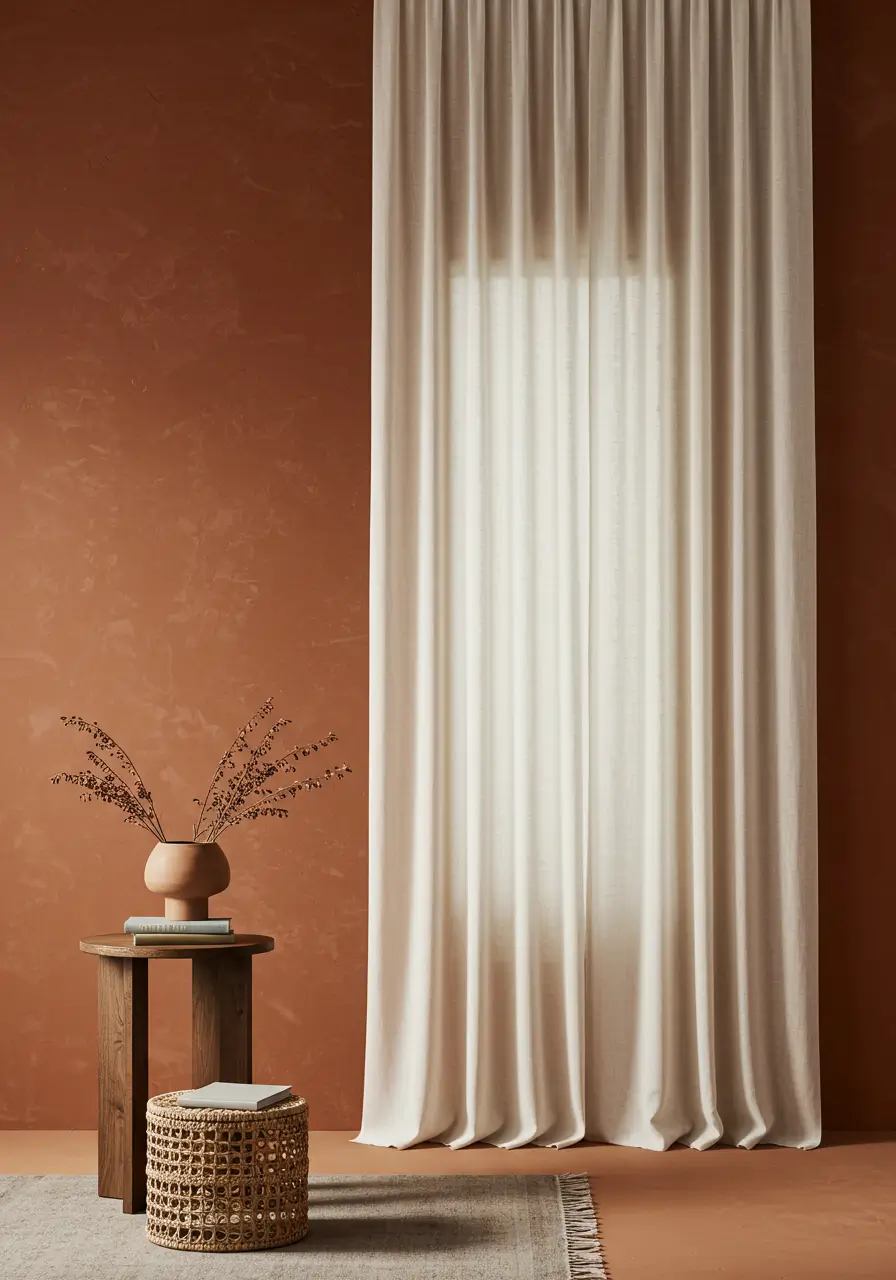
Why it’s Chic:
Terracotta walls bring a rich, earthy warmth to a space. Cream or ivory curtains provide a soft, light contrast that prevents the terracotta from feeling too heavy, while still maintaining the overall warm and inviting atmosphere. This pairing is perfect for creating a rustic yet refined look.
Best Rooms:
Living rooms, kitchens, dining areas, or sunrooms, especially those with natural wood elements or bohemian/Mediterranean influences.
8. Layered Sheer White Curtains with Heavier Natural Linen Drapes (Against Any Soft Wall Color)
The Vibe:
Soft, ethereal, textured, and effortlessly elegant. Offers great light control.
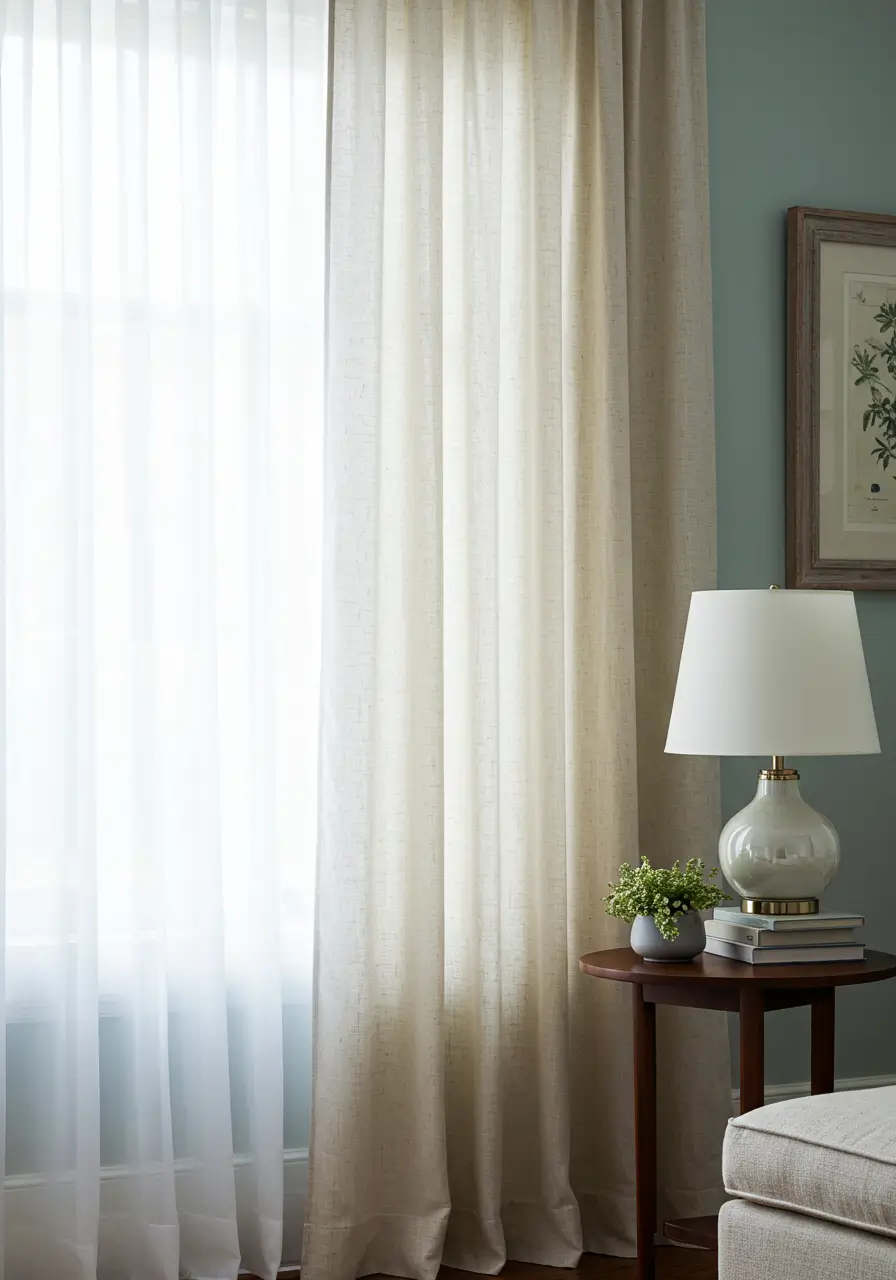
Why it’s Chic:
Layering provides both functionality and beauty. The sheer white curtains diffuse daylight beautifully and offer privacy, while the heavier linen drapes (in a natural beige, greige, or off-white) add texture, warmth, and can be drawn for complete light blockage or insulation. This works with almost any soft wall color, from pale blues and greens to warm neutrals.
Best Rooms:
Bedrooms and living rooms where flexible light control and a luxurious, hotel-like feel are desired. A universally appealing Curtain Color strategy.
9. Dove Grey Curtains with White Walls and Black Accents
The Vibe:
Minimalist, contemporary, and sharply sophisticated.
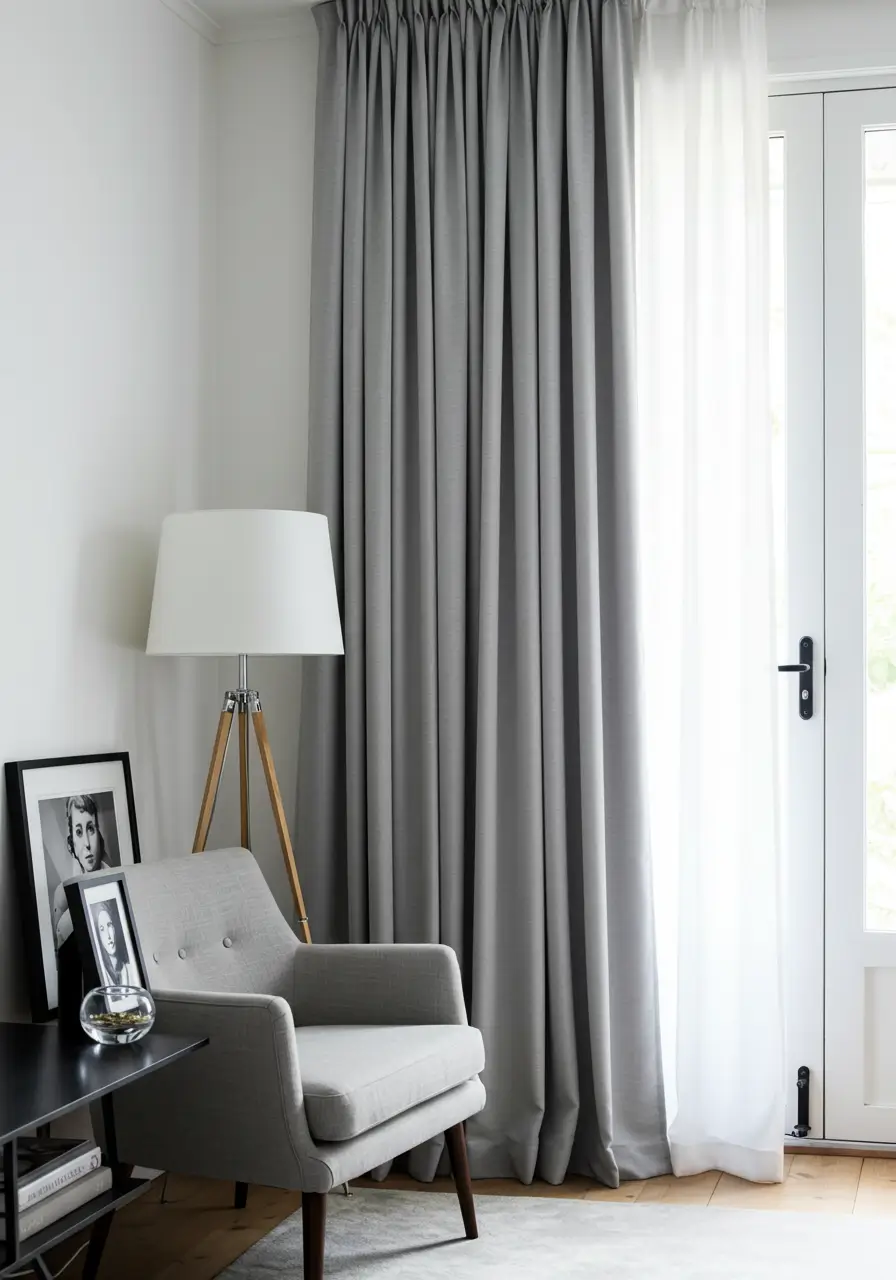
Why it’s Chic:
This creates a clean, almost graphic look. Soft dove grey curtains provide a gentle contrast against crisp white walls. Introducing small, deliberate black accents elsewhere in the room (e.g., picture frames, a lamp base, hardware) ties the scheme together for a very polished and modern aesthetic.
Best Rooms:
Modern living rooms, home offices, contemporary bedrooms.
10. Patterned Curtains (e.g., Subtle Botanical or Geometric) with a Solid Wall Color Picked From the Pattern
The Vibe:
Personalized, cohesive, and visually interesting.
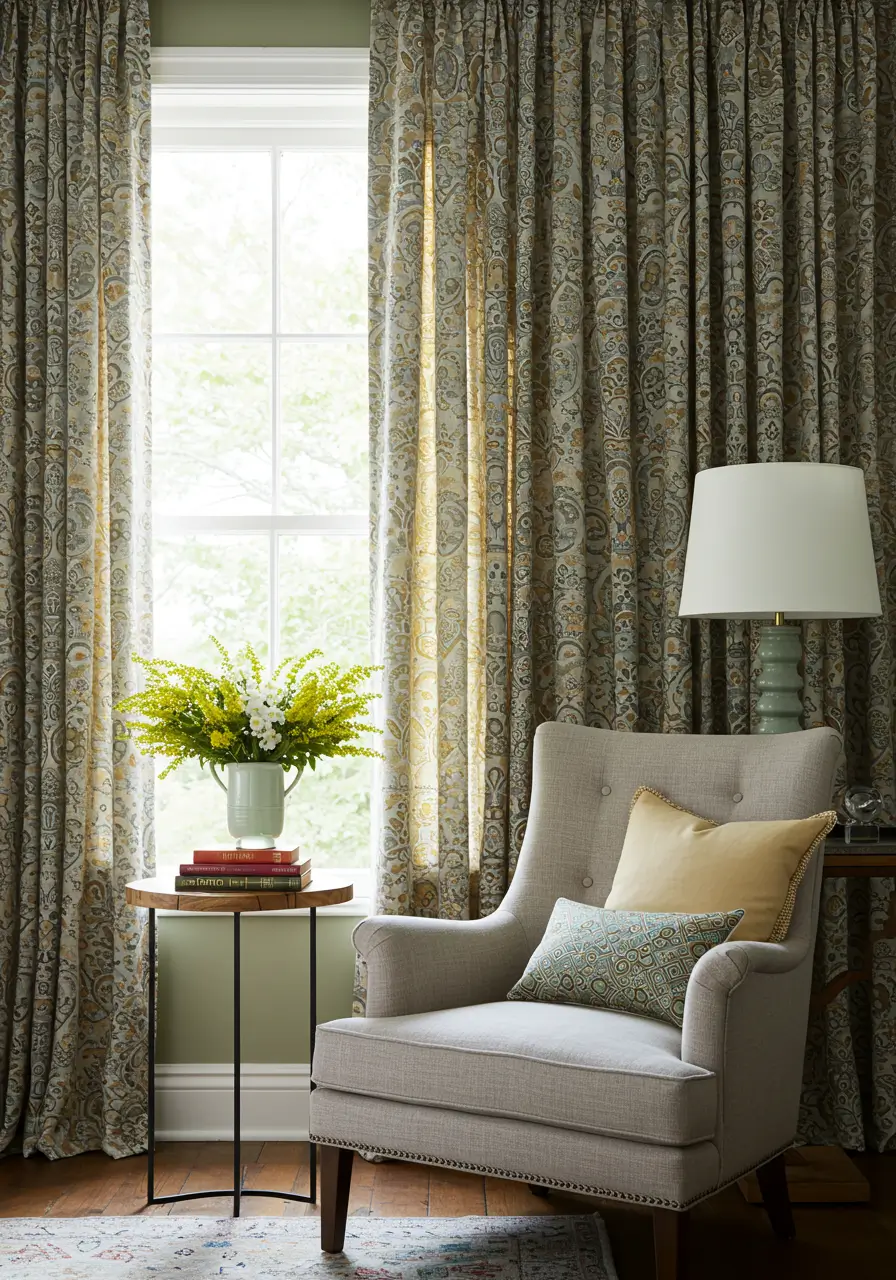
Why it’s Chic:
Choosing patterned curtains adds depth and personality. To ensure a harmonious look, select a pattern that isn’t too overwhelming for the room size. Then, pick one of the less dominant colors from the curtain pattern to use as your solid wall color, or as a major accent color elsewhere in the room. This creates an intentional and well-coordinated design.
Best Rooms:
Living rooms, bedrooms, dining rooms. Ensure the scale of the pattern is appropriate for the room.
11. Warm Greige Curtains with Soft White Walls
The Vibe:
Cozy, modern neutral, sophisticated, and versatile.
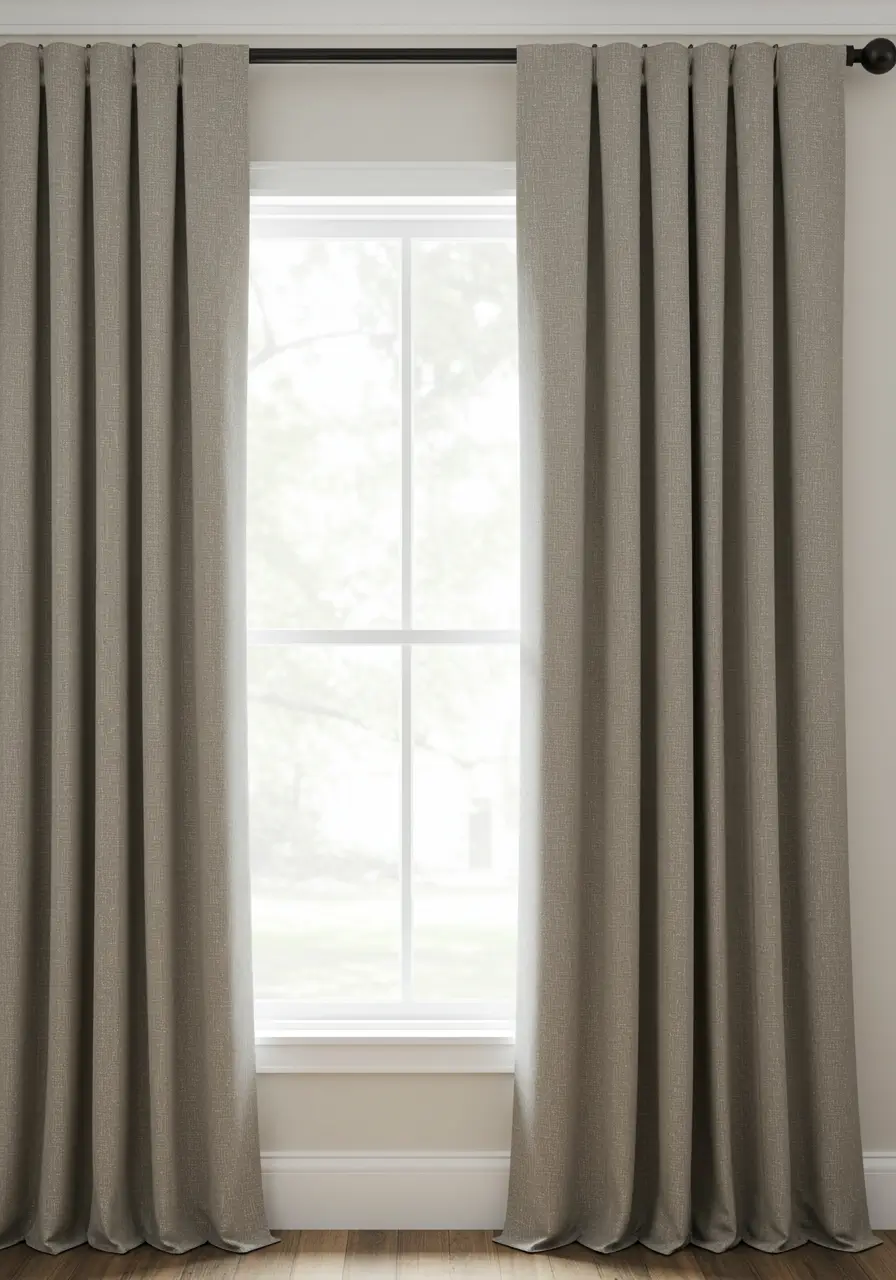
Why it’s Chic:
Greige (a blend of grey and beige) is a highly popular neutral that offers more warmth than plain grey but remains sophisticated. Pairing greige curtains with soft white (not stark white) walls creates a subtle, inviting, and very current look. It’s a perfect backdrop for various decor styles and allows for easy introduction of other accent colors. This is a go-to modern Curtain Color.
Best Rooms:
Virtually any room – living rooms, bedrooms, family rooms, home offices.
12. Rich Burgundy or Plum Curtains with Creamy Beige or Warm Grey Walls
The Vibe:
Luxurious, traditional, cozy, and dramatic.
Why it’s Chic:
Deep burgundy or plum curtains, especially in fabrics like velvet or heavy linen, bring a sense of opulence and warmth. Pairing them with creamy beige or a warm-toned grey wall prevents the room from feeling too dark while allowing the rich curtain color to be the star. This combination is perfect for creating a cozy and inviting retreat.
Best Rooms:
Formal dining rooms, master bedrooms, traditional living rooms, or libraries.
This Chic Curtain Color Ideas List provides a fantastic starting point. Remember to consider your personal taste and the unique characteristics of your space when making your final selections!
Factors to Consider When Choosing Your Curtain Color Combinations
While our Chic Curtain Color Ideas List offers great inspiration, selecting the perfect pairing for your home involves more than just picking two colors you like. Several practical and aesthetic factors should guide your decision to ensure your chosen curtains look beautiful and function well within your specific space.
Room Size and Natural Light Levels
This is a crucial consideration, as color can dramatically affect the perception of space.
Small or Dark Rooms:
If your room is small or doesn’t receive a lot of natural light, opting for lighter Curtain Color combinations is generally advisable. Light colors like white, cream, pale grey, soft pastels, or even light-toned sheers can help make the space feel more open, airy, and brighter by reflecting available light. Avoid very dark or heavy curtains, as they can absorb light and make the room feel more enclosed and smaller than it is. A monochromatic scheme with curtains a few shades lighter than the walls can also enhance the sense of space.
Large or Bright Rooms:
In larger rooms with ample natural light, you have much more flexibility with your Curtain Color choices. You can confidently embrace darker shades, bolder patterns, or richer jewel tones without worrying about them overwhelming the space. In fact, deeper colors can add a sense of coziness and intimacy to a very large room. If intense sunlight is an issue, consider curtains with good light-blocking properties (like blackout linings) or layer sheer curtains with heavier drapes for versatile light management.
Existing Furniture and Overall Decor Style
Your curtains need to feel like an integral part of your room’s existing design, not an afterthought.
Harmonizing with Furniture:
Look at the dominant colors and patterns in your existing furniture, especially large pieces like sofas, armchairs, or your bedspread. Your chosen Curtain Color could:
– Pick up a secondary or accent color from a patterned rug, sofa, or artwork.
– Complement the main color of your largest furniture pieces (e.g., neutral curtains with a bold colored sofa, or vice versa).
– Provide a neutral backdrop if other elements in the room (like a statement rug or vibrant artwork) are very bold and colorful.
Aligning with Decor Style:
The Curtain Color and fabric should reflect your room’s established interior decor style. For example:
– Minimalist or Scandinavian: Light neutrals (white, grey, beige), simple textures, clean lines.
– Bohemian or Eclectic: Earthy tones, rich jewel tones, vibrant patterns (ikat, paisley, global prints), textured fabrics like macramé or heavy linen.
– Traditional or Formal: Classic colors (navy, burgundy, forest green, cream), potentially damask, brocade, or subtle floral patterns in heavier fabrics like velvet, silk, or jacquard.
– Modern Farmhouse: Soft neutrals (cream, beige, greige, muted blues/greens), natural linen or cotton fabrics, subtle checks, stripes, or simple botanical prints.
– Coastal: Light blues, sandy beiges, crisp whites, often in lighter fabrics like linen or cotton voile.
Desired Mood and Atmosphere of the Room
The Curtain Color significantly influences the emotional feel of a space. What atmosphere do you want to create?
Calm and Relaxing Spaces (e.g., Bedrooms, Bathrooms):
Opt for cool colors like blues and greens, soft greys, muted pastels (lavender, blush pink), or serene neutrals. These hues are known for their soothing properties.
Warm and Inviting Spaces (e.g., Living Rooms, Dining Rooms):
Consider warm neutrals like cream, beige, or warm grey; or welcoming colors like soft yellows, terracotta, peach, or muted oranges. These colors create a cozy and sociable ambiance.
Energetic and Playful Spaces (e.g., Kids’ Rooms, Sunrooms, Creative Studios):
Brighter yellows, corals, teals, vibrant pinks, or bold patterns can inject energy and fun.
Sophisticated and Dramatic Spaces (e.g., Formal Living/Dining, Master Bedrooms, Home Libraries):
Deep jewel tones (emerald, sapphire, ruby, amethyst), charcoal grey, navy blue, or rich browns can create a sense of luxury, drama, and intimacy.
Curtain Fabric, Texture, and Pattern Scale
The material and finish of the curtain itself influence how the color is perceived and how it contributes to the room’s style.
Fabric’s Influence on Color:
– Matte Fabrics (Linen, Cotton): Colors may appear softer, more natural, or slightly muted.
– Lustrous Fabrics (Velvet, Silk, Sateen): Colors can appear richer, deeper, and more luxurious due to the fabric’s sheen.
– Sheer Fabrics (Voile, Organza): Colors will be translucent, allowing light to filter through and creating a light, airy effect.
Texture’s Role:
Textured weaves (like slub linen, chenille, or corduroy) add depth and tactile interest to solid Curtain Color choices, preventing them from looking flat.
Pattern Scale:
If choosing patterned curtains, ensure the scale of the pattern is appropriate for the room size and window size. Large, bold patterns can overwhelm small rooms, while very small patterns might get lost in large spaces. Consider how the pattern repeats and how it will look when the curtains are both open and closed.
By thoughtfully considering these factors – room characteristics, existing decor, desired mood, and fabric properties – you can confidently select Curtain Color combinations from our Chic Curtain Color Ideas List (or devise your own!) that are both stunningly beautiful and perfectly suited to your home.
Tips for Implementing Your Curtain Color Choices Successfully
You’ve reviewed our Chic Curtain Color Ideas List and considered the crucial factors. Now, a few final tips will help you bring your chosen curtain color combinations to life seamlessly and ensure they look absolutely stunning in your space.
Always, Always Get Fabric Swatches
The Golden Rule of Curtain Selection:
This cannot be emphasized enough. Never make a final Curtain Color decision based solely on how it looks on a computer screen, in a catalog, or even under the bright lights of a store. Colors can vary dramatically depending on lighting and surrounding hues.
Testing in Your Own Environment:
Obtain physical fabric swatches (the larger, the better) of your top curtain choices. Bring them home and view them in the actual room where they will hang. Observe them at different times of day – in bright morning light, softer afternoon light, and under your artificial evening lighting. Hold the swatches directly against your painted walls, next to your sofa upholstery, and near other significant decor elements. This is the only way to truly see how the Curtain Color interacts with your specific space and confirm it achieves the desired effect.
Consider Curtain Length and Fullness for Impact
The way curtains hang significantly impacts their overall chicness.
Choosing the Right Length:
– Floor-Length (Grazing or Kissing the Floor): This is generally the most elegant and popular choice for living rooms and bedrooms. The curtains should just touch the floor or hover about half an inch above it for a tailored look.
– Puddling: Having extra fabric (typically 1-6 inches) pool or “puddle” on the floor creates a very luxurious, formal, or romantic effect. It works best with heavier fabrics like velvet or silk but can collect dust and may not be practical in high-traffic areas or homes with pets/small children.
– Sill or Apron Length: Shorter lengths are more casual and practical for windows where long drapes are impractical (e.g., above radiators, in kitchens, or some bathroom windows).
Achieving Proper Fullness:
For a rich, luxurious appearance, curtain panels should generally have a combined width that is 2 to 2.5 times the width of your window (or the area you intend to cover). Skimpy curtains that barely cover the window when closed can look cheap and unfinished, detracting from even the most beautiful Curtain Color.
Don’t Overlook Curtain Hardware
The supporting elements are part of the overall design.
Rods, Rings, Finials, and Tie-Backs:
The curtain rod itself, along with any rings, finials (decorative end pieces), and tie-backs, should complement both your chosen Curtain Color and fabric, as well as the overall style of your room. Finishes like matte black, brushed nickel, antique brass, oil-rubbed bronze, or various wood tones can add a subtle or significant design detail.
Strategic Rod Placement:
To make windows appear taller and grander, mount the curtain rod several inches (4-6 inches or more) above the window frame, closer to the ceiling if possible. Extending the rod 3-6 inches wider than the window frame on each side allows the curtain panels to be drawn fully clear of the glass when open, maximizing natural light and the view.
Layering for Depth and Versatility
Sheers with Opaque Drapes:
As highlighted in our Chic Curtain Color Ideas List, layering a lightweight sheer curtain (for daytime privacy and beautifully diffused light) underneath heavier opaque drapes offers maximum flexibility in light control and privacy. This also allows for interesting combinations of color and texture. For example, a patterned sheer with a solid drape, or two complementary neutral tones.
Curtains Over Blinds or Shades:
You can also add decorative curtain panels over existing functional window treatments like Roman shades, cellular shades, or roller blinds. This softens the look, adds color and pattern, and can improve insulation or light blockage.
By paying close attention to these implementation details, from testing swatches to selecting appropriate hardware and considering layering options, you ensure that your chosen Curtain Color combinations are showcased to their fullest potential, resulting in truly chic and well-dressed windows.
Dressing Your Windows: The Impact of Perfect Curtain Color Pairings
The journey to perfectly dressed windows, culminating in the selection from a Chic Curtain Color Ideas List, is a rewarding one. Choosing the right Curtain Color combinations does more than just cover a window; it infuses your space with personality, sets the desired mood, and harmonizes all the elements of your interior decor. Whether you’ve opted for the serene elegance of layered neutrals, the bold sophistication of navy and white, or the earthy warmth of olive and cream, the impact on your room’s atmosphere will be tangible.
Remember that the most successful curtain choices come from a blend of understanding basic color principles, considering the unique characteristics of your space (light, size, existing decor), and, most importantly, trusting your personal style. Testing fabric swatches in your own home is an indispensable step, ensuring the colors translate beautifully from inspiration to reality. Don’t overlook the details of length, fullness, and hardware, as these complete the polished look.
Ultimately, the perfect Curtain Color pairings are those that make your house feel more like a thoughtfully curated home – a space that is not only visually stunning but also deeply comfortable and a true reflection of you. May this Chic Curtain Color Ideas List inspire you to transform your windows into captivating focal points, enhancing the beauty and ambiance of every room.
Frequently Asked Questions
Should curtains be lighter or darker than walls?
There’s no hard and fast rule, as it depends on the effect you want to achieve. Curtains a few shades lighter or darker than the walls create a subtle, cohesive (monochromatic) look. Lighter curtains can make a room feel airier, while darker curtains can add drama or coziness. For a bolder statement, a contrasting Curtain Color (either much lighter or much darker, or a complementary color) can be used.
What curtain colors make a room look bigger?
Light, cool, and neutral Curtain Color choices tend to make a room feel more spacious and open. Think whites, creams, pale greys, soft blues, or light pastels. Keeping the curtain color similar to the wall color also helps create an uninterrupted visual flow, enhancing the sense of space. Sheer fabrics that allow light through contribute to this effect as well.
How do I choose curtain colors if I have patterned wallpaper?
If your wallpaper has a prominent pattern, it’s generally best to choose solid-colored curtains to avoid a visually overwhelming or clashing look. Select a Curtain Color that picks up one of the less dominant accent colors from your wallpaper pattern for a coordinated feel. Alternatively, a neutral curtain color (like cream, beige, or a grey that complements the wallpaper’s background) can provide a calming balance.
Are patterned curtains still in style for 2025?
Yes, patterned curtains remain a stylish option for 2025. The trend leans towards more sophisticated, nature-inspired, or subtly geometric patterns rather than overly fussy or dated florals. Think organic botanicals, abstract designs, classic stripes, or refined geometric prints. The key is ensuring the pattern’s scale and colorway complement the room’s overall decor and don’t compete with other strong patterns.
What curtain color is best for a bedroom to promote sleep?
For a bedroom, cool and calming Curtain Color choices are generally best for promoting a restful atmosphere conducive to sleep. Shades of blue (especially muted or dusty blues like navy or sky blue), green (such as sage or mint), and soft greys or lavenders are excellent options. Darker versions of these colors can also be very effective, particularly if they are made from light-blocking fabrics to ensure a dark sleeping environment.
This Post Contains Affiliate Links




